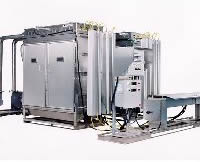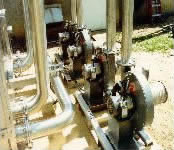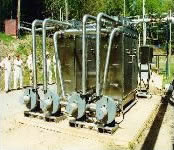
![]()
 |
| 650 SCFM photocatalytic pollution control unit. (Photo: S. Spencer) |
|---|
FSEC researcher developed, designed and assisted in the installation of a 650-standard cubic foot per minute (SCFM) photocatalytic pollution control unit that was installed and operated at Indian Head Naval Surface Warfare Center in Indian Head, Maryland. The pollution control unit was built by Trojan Technologies, Inc., of London, Ontario, Canada, according to FSEC's design and specifications. The unit was used by the Navy on one of their propellant annealing ovens and was capable of treating 1300 SCFM air contaminated with nitroglycerine vapor and other contaminants emitted from propellant grain annealing operations.
After seven years and hundreds of careful laboratory experiments, FSEC researchers developed and field-tested a new photocatalytic oxidation process. The patented process employs a unique reactor design and titania-based photocatalytic cartridge activated by ultraviolet (UV) radiation. In this process, photo-generated radicals on the titania surface react with and break down the adsorbed organic pollutants.
The advantage of FSEC's photoreactor unit is that it continuously generates the needed oxidants, in-situ, requiring only electricity and no added consumable chemicals. The unit uses 64 low-cost and highly efficient low-pressure mercury lamps (LPMLs) as the UV light source.
 |
| Air compressors providing coolant for high-efficient, low-pressure mercury vapor lamps. (Photo: S. Spencer) |
|---|
 |
| Pollution control unit installation at Navy site. (Photo: S. Spencer) |
|---|
FSEC's photocatalytic pollution control unit (PPCU) consists of two identical modules. Each is capable of treating 650-SCFM air contaminated with nitroglycerine vapor and other contaminants emitted from propellant grain annealing operations.
